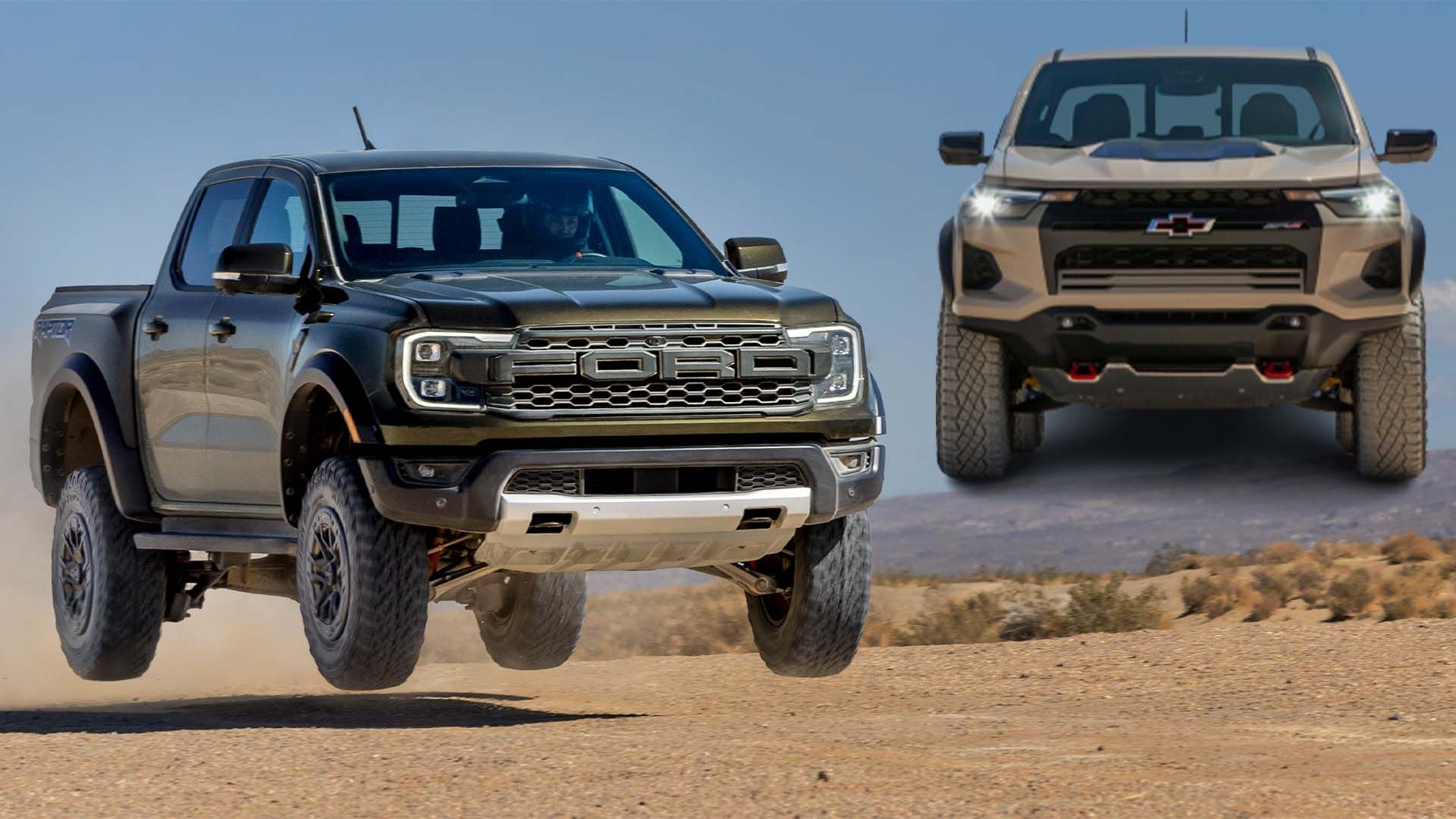How the 2024 Ford Ranger Raptor Compares to the Chevy Colorado ZR2
At long last, Ford has revealed its redesigned midsize pickup truck in full, and that means we have a complete picture of its angriest off-road model: the 2024 Ford Ranger Raptor. What you're all wondering is how it compares to GM's equivalent, the 2023 Chevrolet Colorado ZR2 (and by extension, the 2023 GMC Canyon AT4X). Well, we've crunched the numbers, and we think we know where each truck will excel—or could fall short.
For starters, let's look at what traits the most aggressive off-road Ranger and Colorado share. They're both midsize crew-cab pickups of nearly the same dimensions, with similar weights, and beds of about the same size. Each has a turbo engine making 430 pound-feet of torque, top-shelf off-road dampers, skid plates to armor their engines, and two-speed, four-wheel-drive transfer cases.
Both also feature locking diffs front and rear, solid axles out back, and identical ground clearance at 10.7 inches. That's in part because they use the same tire size, 33-inch 285-sections, mounted to 17-inch, bead lock-capable wheels. Each have a class win at a major off-road race to their name—Chevy at the Mint 400, Ford at the Baja 1000.
From these alone, you could be forgiven for thinking these trucks are interchangeable. But dig deeper into their specs and you'll find their purposes mirror those of their larger counterparts, the Silverado ZR2 and F-150 Raptor, which are optimized for very different kinds of off-road driving.
2024 Ford Ranger Raptor
Powertrain: 3.0-liter twin-turbo V6 | 10-speed automatic transmission | four-wheel drive with high and low ranges
3.0-liter twin-turbo V6 | 10-speed automatic transmission | four-wheel drive with high and low ranges Horsepower: 405
405 Torque: 430 lb-ft
430 lb-ft Curb weight: 5,325 pounds
5,325 pounds Bed length: 59.6 inches
59.6 inches Payload capacity: 1,411 pounds
1,411 pounds Towing capacity: 5,510 pounds
5,510 pounds Off-road angles: 33° approach | 24.2° breakover | 26.4º departure
33° approach | 24.2° breakover | 26.4º departure Ground clearance: 10.7 inches
2023 Chevy Colorado ZR2
Powertrain: 2.7-liter turbocharged inline-four | 8-speed automatic transmission | four-wheel drive with high and low ranges
2.7-liter turbocharged inline-four | 8-speed automatic transmission | four-wheel drive with high and low ranges Horsepower: 310 @ 5,600 rpm
310 @ 5,600 rpm Torque: 430 lb-ft @ 3,000 rpm
430 lb-ft @ 3,000 rpm Curb weight: 5,298 pounds
5,298 pounds Bed length: 62 inches
62 inches Payload capacity: 1,152 pounds
1,152 pounds Towing capacity: 6,000 pounds
6,000 pounds Off-road angles: 38.3° approach | 24.6° breakover | 25.1° departure
38.3° approach | 24.6° breakover | 25.1° departure Ground clearance: 10.7 inches
The Colorado ZR2's capabilities are defined by design choices concerning its chassis and suspension, starting with its significantly better approach angle of 38.3 degrees compared to the Ford's 33. It rolls on Goodyear Wrangler Territory MT tires, giving it sure footing on the worst surfaces, and it uses cast-iron suspension arms compared to the Raptor's forged aluminum. How its Multimatic DSSV shocks compare to the Ford's Fox Live Valve units will only be determined with test drives, though.
What's clearer is that the ZR2 has a better tow rating at 6,000 pounds to the Ford's 5,510, and comes in a hair lighter with a slightly larger bed—though by a mere 2.4 inches. And while it's already a wide truck, it's the narrower of the two.
By no means is the win decisively Chevy's, though, because the Raptor makes some mighty convincing arguments, starting with its 3.0-liter Ecoboost V6. Compared to the Chevy's 2.7-liter four-banger, it makes 95 more horsepower that it can use in two more gears, with a 10-speed auto to the Chevy's eight-speed. Its underbody protection is also steel instead of the ZR2's aluminum and armors the fuel tank too.
The Raptor offers a significantly better payload rating at 1,411 pounds to Chevy's 1,152, while its wider stance, shorter wheelbase, lower profile, and all-terrain tires grant better handling over a wider variety of surfaces. (The regular Colorado can feel unwieldy at times, and the softer ZR2 probably won't improve that.)
Also, regarding those race wins: Ford's truck survived the race and drove home; Chevy's tweaked its spine near the finish line.
Again, like their bigger brothers in their respective lineups, the ZR2 and Raptor are designed to do different things. The Chevy's more of a trail crawler, while the Raptor is for when you get the zoomies. Even so, the Raptor is clearly equipped to tackle trails too, especially with its low crawl ratio and Trail Control tech.
At the end of the day, these trucks are both at home doing whatever you ask them (within reason). But you may still find that one does what you want better—or perhaps that the Ford's numerous advantages are too big to overlook.
Source: The Drive


